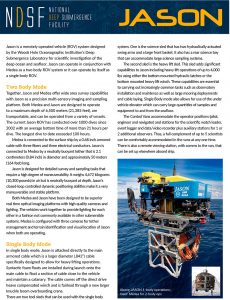Dive with Jason
Persistent, reliable access to the seafloor
Fact Sheet
ROV Jason
Jason can be operated as either a two-body or a single-body ROV, depending on mission requirements. A 10-kilometer (6-mile) reinforced fiber-optic cable delivers electrical power and commands from the ship to the vehicle, which then returns data and live video imagery throughout a multi-day dive.
Jason is equipped with sonars, video and still imaging systems, lighting, and numerous sampling systems. Jason's manipulator arms collect samples of rock, sediment, or marine life and place them in the vehicle's basket or on "elevator" platforms that float heavier loads to the surface.
Pilots and scientists work from a control room on the ship to monitor Jason's instruments and video while maneuvering the vehicle. The average Jason dive lasts one to two days, though operators have kept the vehicle down for as long as seven days.
The system has been used to make hundreds of dives to hydrothermal vents in the Pacific, Atlantic, and Indian Oceans. ROV Jason is now in its third generation, with a sturdier, more flexible vehicle being launched in 2016 that includes:
- New bigger and stronger cable tether with break strength (BS) of 70,000 pounds compared to the traditional cable tether with a BS of 42,000 pounds, allowing the heavy lift operations of up to 4,000 lbs.
- A modified Active Heave Compensated winch to accommodate the new cable
- A new Launch and Recovery System (LARS) that accommodates the increased payload rated to 15,000 pounds.
- A new vehicle frame capable of withstanding the increased loads.
- A new swappable heavy-lift tool skid that will be used for these lift operations.
- New science tool skid with increased space and payload for scientific equipment.
- Additional flotation to accommodate the increase in weight of the new frame.
Vehicle Tour
Jason Video
Get a deeper understanding of what Jason can do.
Warm, alkaline fluid gently flowing through carbonate deposits at the top of the Poseidon edifice at the Lost City hydrothermal field.
In 2015, the remotely operated vehicle Jason began a year-long, $2.4 million upgrade that culminated in a complete rebuild of the vehicle during the winter of 2016.
When a trigger mechanism failed to release a key deep-sea instrument, WHOI physical oceanographer Ruth Curry brought together a gung-ho team to try to retrieve it.
WHOI expedition leader Will Sellers talks about the adventure of deep-sea research at an erupting underwater volcano.
Using the dexterous mechanical arms of the remotely operated vehicle Jason, pilots and scientists removed lava chunks from a singed ocean-bottom sesimometer, freeing it to float back to the surface.
Oceanographers using the remotely operated vehicle (ROV) Jason discovered and recorded the first video and still images of a deep-sea volcano actively erupting molten lava on the seafloor.

